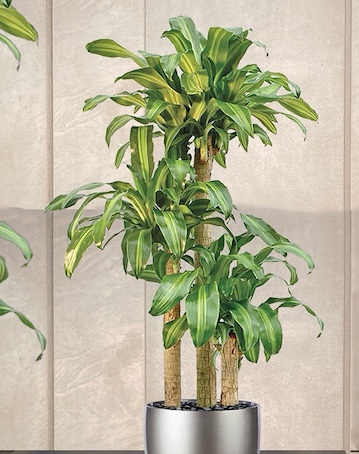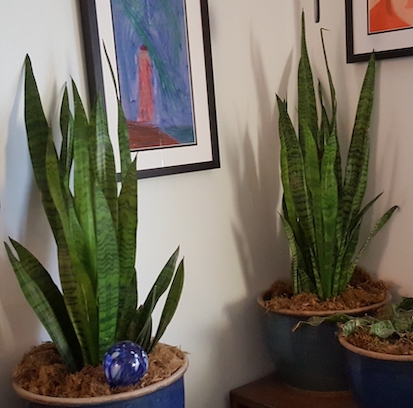Dracaena — The Perfect House Plant
by Nancy Miller, Fairfax Master Gardener

Dracaena fragrans
If you need a rugged and stress-free houseplant, check out the various types of dracaenas (dra-SEE-nahs). They are robust, almost pest-free tropical plants that thrive in the home environment. Several different varieties have been growing in my own home for almost 30 years.
Dracaenas are part of a very diverse family of foliage plants. Leaves can be oval or lance-shaped, from 3 to 24 inches (7 to 60 cm) long. They range in color from emerald to gray green, some with white, yellow or cream stripes. Sizes range from “small tabletop” to over 20 feet (6 m) tall. They are slow growing, evergreen perennials in the asparagus family and are native to tropical Africa, where they grow as bushes. You probably already know at least some of this family by their common names: corn plant (Dracaena fragrans), snake plant or mother-in-law’s tongue. Dracaena trifasciata — previously classified as Sansevieria trifasciata), or dragon tree, red dragon tree or Madagascar dragon tree (Dracaena marginata). Each of these in turn has popular cultivars frequently offered for sale.
Cultivation is straightforward. When your plant outgrows its container or if the soil becomes compacted, repot it in a pot slightly larger than the current one, using a well-draining soil mix. Grow in bright, indirect light. The brighter the light, the stronger the foliage and the faster the growth rate, but direct sunlight can cause round dry patches and streaks on the foliage. Each variety varies slightly in the amount of light it requires. Experiment with yours if it seems unhappy.
Optimum growing and rooting temperatures for dracaenas are normal household temperatures, with night temperatures about 10 degrees cooler. Dry tips and edges usually mean the humidity is too low, so mist lightly if necessary. You can also fertilize monthly during the growing season (spring/summer) with all-purpose fertilizer at half strength. If you fertilize too heavily, leaf tips and margins will burn or yellow.

Dracaena trifasciata
Problems most often result from over or under watering. Make sure the soil is free draining. Let the top inch of soil dry out, then water. In the winter, water even less often, or you risk root rot. Some varieties are sensitive to fluoride. If your variety is sensitive, the symptoms will include yellowing of the tips or leaf margins, or dead scorched areas. Be sure to use room temperature, not cold water. Scale insects or mites could be a problem, so it is a good idea to occasionally wipe off any dust that could attract pests.
Propagation and pruning are equally straightforward. If a leaf is damaged, remove it as close to the stem and soil as possible. You can use air layering or root a stem cutting in soil or water to grow a new plant. If your dracaena gets too tall, cut the stem to the desired height. New leaves will form at the cut, and you can stick the stem cutting in soil or water to root for a new plant. You can also grow new plants by removing and rooting basal shoots in spring or late summer.
An additional benefit of the dracaena family is the ability to clean the air, making it a good choice for indoor air quality improvement. If you have pets, you should be aware that these plants have a “low” poison susceptibility, so keep them out of reach of curious teeth.
These are great plants to choose for indirect light situations in your home, no matter what your decor. Try one or two and enjoy some low-effort greenery.
-
References
- Dracaena, Karen Russ and Al Pertuit, Clemson Cooperative Extension
- Dracaena, North Carolina State University Extension
- Plant of the Week: Red-Edged Dracaena, Gerald Klingaman, University of Arkansas Cooperative Extension Service
- Snake Plant: A Forgiving, Low-maintenance Houseplant, Susan Marquesen, Penn State Extension